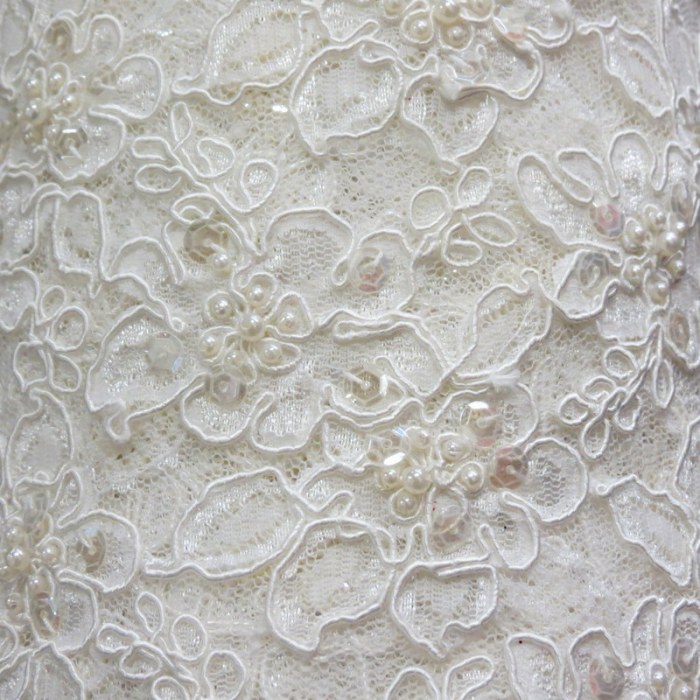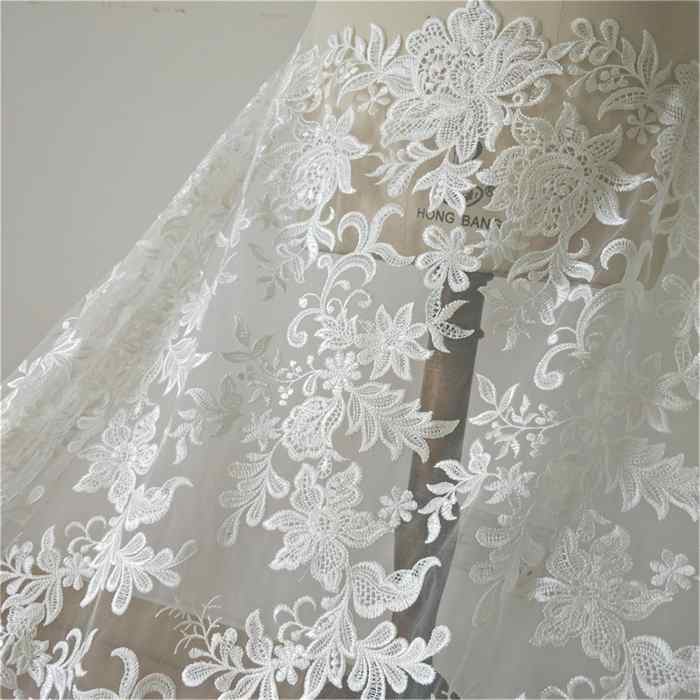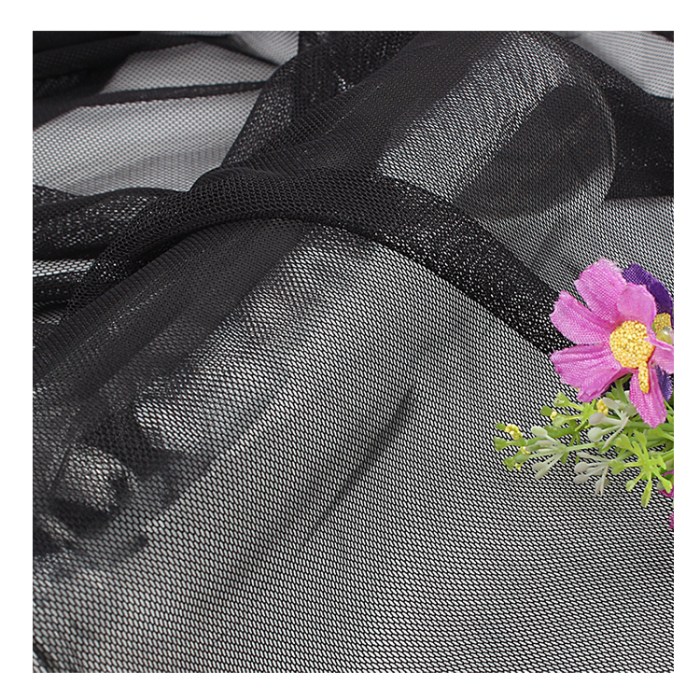Popular Wedding Dress Fabrics
Wedding dress material fabric – Okay, so you’re planning your big day, right? Choosing the perfect wedding dress is, like, totally crucial. And a major part of that is picking the right fabric. It’s all about finding the vibe that screams
-you*, whether that’s boho chic, glam goddess, or classic princess. Let’s dive into the deets on the most popular fabrics and what makes them so fab!
Popular Wedding Dress Fabrics Table, Wedding dress material fabric
Here’s the lowdown on ten totally popular wedding dress fabrics. We’re breaking it down so you can totally slay your dress choice.
| Fabric Name | Common Uses | Pros | Cons |
|---|---|---|---|
| Silk | A-line gowns, ball gowns, sheath dresses | Luxurious, drapes beautifully, breathable | Expensive, requires special care, can wrinkle easily |
| Satin | Mermaid gowns, trumpet gowns, fit-and-flare dresses | Shiny, smooth, elegant | Can show imperfections, less breathable than silk |
| Lace | Bohemian gowns, vintage-inspired dresses, A-line gowns | Romantic, delicate, intricate details | Can be itchy, less durable than other fabrics |
| Tulle | Ball gowns, princess gowns, layered skirts | Lightweight, airy, creates volume | Can be sheer, prone to snags |
| Organza | A-line gowns, ball gowns, princess gowns | Lightweight, crisp, sheer | Can be stiff, not as flattering as other fabrics |
| Chiffon | Flowy gowns, beach weddings, bohemian styles | Lightweight, sheer, drapes well | Can be see-through, easily wrinkled |
| Crepe | Sheath dresses, trumpet gowns, minimalist styles | Structured, drapes well, less wrinkles | Can be stiff, less flowy than other fabrics |
| Charmeuse | Sleek gowns, mermaid styles, figure-hugging dresses | Smooth, luxurious, drapes beautifully | Can be slippery, requires special care |
| Mikado | Structured gowns, ball gowns, A-line gowns | Durable, crisp, holds shape well | Can be heavy, less flowy |
| Taffeta | Ball gowns, princess gowns, structured silhouettes | Crisp, holds shape well, adds volume | Can be stiff, less breathable |
Historical Significance of Wedding Dress Fabrics
Some fabrics have a seriously rich history when it comes to wedding dresses. These aren’t just fabrics; they’re, like, total storytellers.
Silk has been a symbol of luxury and wealth for centuries, making it a popular choice for royal weddings and high-society events. Think of those iconic historical gowns – silk was the ultimate status symbol. Satin, with its shimmering surface, also carries a long tradition, representing elegance and sophistication. Finally, lace, with its intricate patterns, has been associated with romance and femininity for ages, often symbolizing purity and innocence in bridal wear.
Wedding Dress Styles and Fabric Matches
The right fabric can totally transform the look of your dress. It’s all about finding the perfect match for your style.
- Silk: Perfect for classic A-line gowns, flowing ball gowns, or sleek sheath dresses.
- Satin: Ideal for figure-hugging mermaid gowns, trumpet styles, or elegant fit-and-flare dresses.
- Lace: Stunning for romantic bohemian gowns, vintage-inspired dresses, or delicate A-line silhouettes.
- Tulle: Amazing for voluminous ball gowns, princess-style dresses, or layered skirts that add a touch of whimsy.
- Organza: Great for structured A-line gowns, ball gowns, or princess-style dresses with a crisp, structured look.
- Chiffon: Perfect for flowing, breezy gowns, especially suitable for beach weddings or bohemian styles.
- Crepe: Ideal for sheath dresses, trumpet gowns, or minimalist styles that emphasize clean lines and structure.
- Charmeuse: Stunning for sleek, figure-hugging gowns, mermaid styles, or dresses that showcase a polished, sophisticated look.
- Mikado: Great for structured gowns, ball gowns, or A-line dresses that need to hold their shape and provide a strong silhouette.
- Taffeta: Perfect for ball gowns, princess gowns, or structured silhouettes where a crisp, voluminous look is desired.
Fabric Properties and Suitability
Knowing the properties of different fabrics is key to picking the perfect dress for your body and the weather. Let’s break it down, fam.
Comparing Fabric Properties
Here’s a quick rundown of the key differences between silk, satin, lace, and tulle. These four are total staples in the wedding dress world.
- Silk: Drapes beautifully, luxurious texture, medium-weight, breathable.
- Satin: Smooth, shiny, medium-weight, less breathable than silk.
- Lace: Delicate, intricate texture, lightweight, can be itchy.
- Tulle: Lightweight, airy, sheer, creates volume.
Breathability and Comfort in Different Climates
The climate you’re getting married in seriously matters. You don’t want to be sweating bullets in a heavy satin dress on a hot summer day, right?
Lightweight fabrics like chiffon, tulle, and silk are best for warmer climates. Heavier fabrics like satin, crepe, and mikado are better suited for cooler weather. Consider the season and location when choosing your fabric.
Wedding Dress Fabric Price Comparison
| Fabric Name | Price Range |
|---|---|
| Silk | $$$ |
| Satin | $$ |
| Lace | $$-$$$ |
| Tulle | $ |
| Organza | $$ |
| Chiffon | $ |
| Crepe | $$ |
| Charmeuse | $$$ |
| Mikado | $$ |
| Taffeta | $$ |
Note: Price ranges are relative and can vary depending on quality, embellishments, and designer.
Fabric Care and Maintenance
Okay, so you’ve got your dream dress. Now, let’s talk about keeping it looking amazeballs for years to come.
Cleaning and Storage of Delicate Fabrics
Proper care is key to preserving your wedding dress. Here’s the scoop on cleaning and storing silk, satin, lace, and tulle.
- Silk and Satin: Dry clean only. Store in a breathable garment bag in a cool, dry place.
- Lace: Hand wash gently in cool water with a mild detergent. Lay flat to dry. Store in a breathable garment bag.
- Tulle: Spot clean with a damp cloth. Lay flat to dry. Store in a breathable garment bag.
Stain Removal Guide
Accidents happen! Here’s how to tackle common stains.
- Act fast: Blot (don’t rub!) the stain immediately.
- Identify the stain: Different stains require different treatments.
- Test a hidden area: Before applying any cleaning solution, test it on an inconspicuous area to ensure it doesn’t damage the fabric.
- Use appropriate cleaning methods: For example, use a mild detergent and cool water for most stains. For tougher stains, consult a professional dry cleaner.
- Rinse thoroughly: After cleaning, rinse the affected area thoroughly with cool water.
- Air dry: Allow the garment to air dry completely before storing.
Long-Term Preservation
To keep your dress looking its best for decades, consider professional preservation services. They’ll clean and store your dress in an acid-free environment, protecting it from damage and discoloration.
Choosing the Right Fabric for Your Body Type
Your body type should totally influence your fabric choice. Let’s find the fabrics that flatter your shape.
Flattering Fabrics for Different Body Shapes

Source: discountfabrics-sf.com
Different fabrics can visually enhance or minimize certain features. Here’s a general guide:
- Pear Shape: Fabrics with structure, like crepe or mikado, can balance proportions. Avoid clinging fabrics.
- Hourglass Shape: Flowy fabrics like chiffon or silk can accentuate curves. Structured fabrics can also work well.
- Apple Shape: Fabrics with drape, like silk or chiffon, can create a more flattering silhouette. Avoid stiff fabrics that add bulk.
Visual Guide to Fabric Effects

Source: etsystatic.com
Imagine a pear-shaped bride in a crepe sheath dress – the structured fabric creates a balanced silhouette. Now picture an hourglass figure in a flowing silk gown – the fabric beautifully accentuates the curves. An apple shape looks stunning in a dress made of silk charmeuse, where the drape creates a soft, elegant line. Stiff fabrics might add unwanted volume to areas that are already fuller.
Fabric and Wedding Dress Silhouette
Fabric choice directly impacts the overall silhouette. A structured fabric like mikado creates a strong, defined shape, while a flowing fabric like chiffon creates a softer, more romantic look. The fabric’s weight and drape significantly influence the final look of the dress.
Sustainable and Ethical Fabric Options
More and more brides are choosing sustainable and ethical options for their wedding dresses. Let’s explore some eco-friendly choices.
Environmental Impact of Wedding Dress Fabrics
The production of many fabrics has a significant environmental impact, from water consumption and pollution to carbon emissions. Silk production, for instance, requires considerable resources. Synthetic fabrics often contribute to plastic waste.
Sustainable and Ethical Fabric Examples
- Organic cotton: Grown without harmful pesticides and fertilizers.
- Tencel: A sustainable fabric made from wood pulp.
- Hemp: A durable, eco-friendly fabric.
- Recycled fabrics: Made from pre-consumer or post-consumer textile waste.
Resources for Sustainable Wedding Dress Designers
Many designers are now committed to sustainable and ethical practices. Research designers who use organic and recycled materials, and prioritize fair labor practices. Look for certifications and transparency in their supply chains.
Fabric and Wedding Dress Design: Wedding Dress Material Fabric
The fabric you choose totally dictates what kind of design details you can achieve. Let’s explore the possibilities.
Fabric’s Influence on Design Elements
The choice of fabric impacts everything from beading and embroidery to embellishments and overall structure. Delicate lace, for example, is perfect for intricate embroidery, while a sturdy fabric like mikado is better suited for clean lines and minimal embellishments.
Design Details and Fabric Types
- Lace: Ideal for intricate embroidery, beading, and appliqués.
- Silk: Versatile, can be used with various embellishments, including beading, embroidery, and sequins.
- Tulle: Great for layering, creating volume, and adding delicate embellishments.
- Mikado: Best suited for clean lines, minimal embellishments, and strong structural elements.
Limitations and Possibilities of Fabrics

Source: brisen.biz
Some fabrics are better suited for intricate design work than others. Delicate lace can be easily damaged by heavy embellishments, while a stiff fabric like taffeta might not drape well with intricate folds or gathers. Understanding these limitations is crucial for achieving the desired design.
FAQ Insights
How much should I budget for wedding dress fabric?
Fabric cost varies greatly depending on the type (silk is more expensive than polyester) and the amount needed for your dress design. Expect to budget a significant portion of your dress cost on the fabric itself.
Can I dye my wedding dress fabric?
Some fabrics dye better than others. It’s best to consult a professional cleaner or tailor before attempting to dye your dress. Silk and delicate laces may not take dye well.
How do I know if a fabric is ethically sourced?
Choosing the perfect wedding dress fabric is a journey of textures and dreams. The drape of the material, its whisper against the skin, speaks volumes. For those with an apple shape, finding the right silhouette is paramount, and a helpful guide can be found here: wedding dress for apple shape. Ultimately, the fabric’s caress against your form, whether silk’s gentle embrace or lace’s intricate dance, will complete your bridal vision.
Look for certifications like GOTS (Global Organic Textile Standard) or Fairtrade. Research designers and brands known for their commitment to ethical and sustainable practices. Transparency in sourcing is key.
What fabric is best for a plus-size wedding dress?
Supportive fabrics like crepe, mikado silk, or heavier satin can create a flattering silhouette. Avoid fabrics that cling too much or are too sheer.
